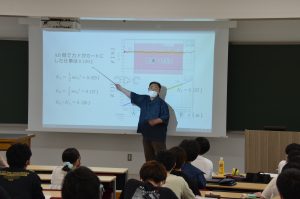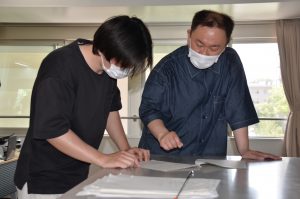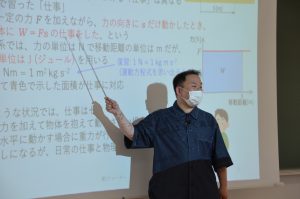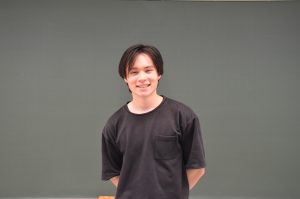In this class, students review high school mathematics such as derivatives and integrals and then apply them to high school physics, reevaluating the formulas learned in high school physics. This is intended to help students understand the origins and definitions of formulas and acquire the ability to smoothly transition to specialized subjects.
Lesson Content
 The class was conducted using an original resume, with key concepts, formulas, and calculation processes highlighted in white, so that students could fill in the blanks as they listened to the explanations.
The class was conducted using an original resume, with key concepts, formulas, and calculation processes highlighted in white, so that students could fill in the blanks as they listened to the explanations.
The topic of the class we interviewed was mechanical energy and its conservation laws. The concepts of work, kinetic energy, and potential energy learned in high school physics were explained in terms of new ideas and their origins in university physics. Formulas that were previously just memorized were broken down in this class, and by using formulas and calculus to show each and every phenomenon, students learned the true meaning and definition of the formulas.
He explained that “work” in physics, which is based on how much force is applied and how far it is moved, is a different concept from “work” in everyday life and “work” in physics. As an example, he introduced that if a person continues to hold a load with force but does not move it, it is “zero” work.
Reference: When an object is moved s in the direction of the force while a constant force F is applied to it, the force says the object has done W=Fs work.”
In the concepts of kinetic energy and potential energy, it was also explained that the concept of whether the same phenomenon is viewed differentially or integrally is important for future professional education, and the differentiation and integration in high school mathematics learned in the first half of this class were used as a method to deepen understanding of each formula. The differential and integral calculus in high school mathematics, which were studied in the first half of the class, were used as a method to deepen understanding of each formula. The content of the class was designed to enable students to understand each phenomenon and definition from the decomposed formulas and to learn their origins.
At the end of the class, students were given exercises using the concepts and definitions they had learned that day to confirm that they had a solid understanding of the concepts. On the spot, questions from the students were accepted, and careful explanations were provided to ensure that the concepts were firmly established as a solid foundation for the next step up. There were also report assignments to be submitted at a later date, and the program was designed to solidify the foundation through repeated review and practice.
Comments from faculty
Physics, as the word “learn the meaning of things” implies, is the study of the mechanisms and logic that give rise to various phenomena in the natural world. Physics is a powerful tool for mankind to quantitatively understand the world around us, making it a truly essential study for college students in the sciences.
However, there may be many students who have a poor understanding of physics, recalling painful memories of having to memorize a lot of formulas with mysterious symbols and being forced to perform calculations incessantly. One of the reasons for this is that the techniques of differentiation and integration, which are indispensable for quantitative description of various phenomena, have not been well utilized in high school physics studies.
 In this course, students will review the differential and integral calculus learned in high school mathematics from the viewpoint of physics, and learn how to treat various concepts learned in high school physics using differential and integral methods. By acquiring a solid understanding of the concept of physics utilizing differential and integral calculus in “Physics I,” we hope that students will dispel the false image that physics requires memorization of numerous formulas and feel that physics is an interesting subject that allows students to understand diverse phenomena with simple logic. I would like you to feel that physics is an interesting discipline that enables us to understand diverse phenomena with simple logic.
In this course, students will review the differential and integral calculus learned in high school mathematics from the viewpoint of physics, and learn how to treat various concepts learned in high school physics using differential and integral methods. By acquiring a solid understanding of the concept of physics utilizing differential and integral calculus in “Physics I,” we hope that students will dispel the false image that physics requires memorization of numerous formulas and feel that physics is an interesting subject that allows students to understand diverse phenomena with simple logic. I would like you to feel that physics is an interesting discipline that enables us to understand diverse phenomena with simple logic.
We hope that this course will also prepare students to enjoy learning more specialized physics such as mechanics and electromagnetism.
Comments from students
BRENNAN TOMI, Faculty of Science
In this lecture, I learned for the first time that physics is not solved by memorizing equations, but by deriving each equation in calculus. This realization made it easier for me to solve seemingly difficult problems under conditions where air and water resistance must be taken into account, which I had not studied in high school.

During the class, the teacher explains various concepts and calculations in an easy-to-understand manner, using slide materials and explanations as well as actual objects by the teacher. Although some knowledge of Math III is required before attending this lecture, during the class, he breaks down the calculations slowly and explains each step, so even though I am a bit of a math whiz, I can catch up with the class with ease. Then, at the end of class, we do specific problem exercises, and submission of these exercises counts as attendance for that class. This and the homework exercises allow me to look back on the class content and further deepen my understanding.
If you are at all interested in physics, please take this class because it will give you the basics of college physics and increase the number of things you can do with physics.

